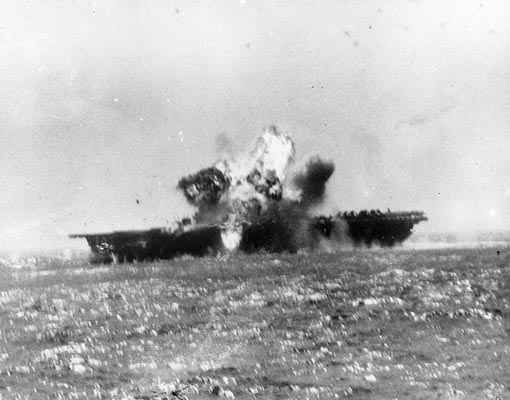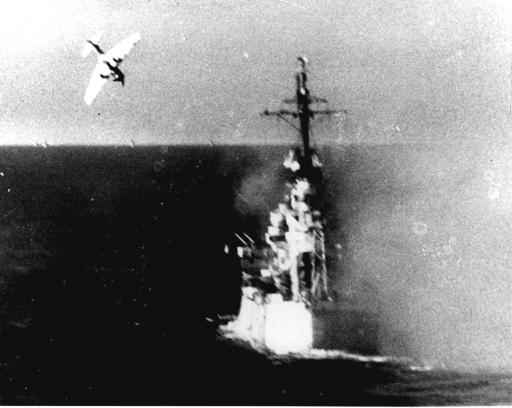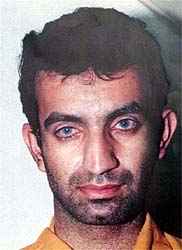|
Kamikaze In the aftermath of September 11, the government engaged in lengthy protests that no one could ever have seen it coming. Aside from the fact that they had specific intelligence that Ramzi Yousef and Khalid Shaikh Mohammed were planning to do exactly that, you don't have to set the Wayback Machine too far back to find other examples of America's enemies using airplanes for offensive weapons.
In the aftermath of September 11, the government engaged in lengthy protests that no one could ever have seen it coming. Aside from the fact that they had specific intelligence that Ramzi Yousef and Khalid Shaikh Mohammed were planning to do exactly that, you don't have to set the Wayback Machine too far back to find other examples of America's enemies using airplanes for offensive weapons. You may recall a little historical obscurity called "World War II". One of the participants in that was a country called "Japan." They had a secret weapon to help turn the tides when the battle was going poorly, namely kamikaze attacks the art of flying an airplane directly into the enemy, usually a naval vessel. The history of kamikaze goes back to the 13th century, when legend has it that Kublai Khan's invading fleet was turned away from Japan by a typhoon sent from the gods (kamikaze translates as "divine wind"). Long thought to be an apocryphal story, recent archaeological excavations have proven the tale true (the fleet part, not the gods part), with the discovery of underwater remains from Khan's fleet. Suicide has always been a much larger component of Japanese culture (which has a lot of issues) than in Western civilization, which never really embraced the idea of "death with honor." Samurai code allowed for the practice of "seppuku," which was a ritual self-disembowelment, popularly known in the West as harakiri. Seppuku was generally used to absolve one's self of some disgrace or defeat. The suicide mindset continues in Japan today, where failed businessmen opt for the "honorable" way out and deranged teenagers take part in Internet suicide pacts for no special reason. Japan has the highest suicide rate among industrialized nations, with more deaths by suicide than by traffic accident. So when Japanese fighter pilots during WWII got into dogfights that were going poorly, they naturally considered the "honorable" option of crashing their planes into enemy airfighters. Crashing an airplane into another airplane is actually trickier than you might think, and generally the only casualty is the other plane, so air-to-air kamikaze wasn't really a cost-effective battle strategy. However, air-to-water kamikaze was another matter. By late 1944, the war was not going as well as the Japanese had hoped. American naval forces were slowly making headway across the Pacific, and the shores of California were looking farther and farther away. After some discussion among the brass, the first formal suicide attack was organized as a volunteer effort (previous suicide attacks had been spur-of-the-moment decisions).
In October, the first attack took place against the U.S. carrier Saint Lo off the coast of the Philippines. Half of the 26 planes were designated for suicide; the other half would capitalize on the ensuing chaos. The attack was a success and the carrier went down. There was no overwhelming trend among the volunteers, except that, like modern suicide bombers, they tended to be young. Although the Japanese cultural obsession with suicide contributed to the pool of willing recruits, the effort was also enhanced by the divine status of the Japanese emperor. The dominant Shinto religion holds that the Japanese emperor, like the Egyptian pharaohs and the Roman Caesars, was a descendant of the gods and a god in his own right. Although not a doctrinal belief, there was also a popular notion that kamikaze pilots would earn a free trip to heaven, just as al Qaeda suicide bombers believe today. Japanese pilots were also trained in special schools, which may have employed brainwashing techniques to soften up potential kamikaze pilots for their eventual missions. By 1945, the tide had decidedly turned in the Pacific, and the Japanese were in retreat. In desperation, the number of suicide attacks were increased, especially in light of their successful psychological effect on American sailors. Nearly 60 ships were sunk by kamikaze attacks in the Pacific and Southeast Asia. Casualities included the USS Bunker Hill and the USS Essex (pictured in this article).
Transcend life and death. When you eliminate all thoughts about life and death, you will be able to totally disregard your earthly life. This will also enable you to concentrate your attention on eradicating the enemy with unwavering determination, meanwhile reinforcing your excellence in flight skills. (...) Just as you cannot fight well on an empty stomach, you cannot deftly manipulate the control stick if you are suffering from diarrhoea, and cannot exert calm judgment if you are tormented by fever. (...) (Just before the crash,) your speed is at maximum. The plane tends to lift. But you can prevent this by pushing the elevator control forward sufficiently to allow for the increase in speed. Do your best. Push forward with all your might. You have lived for 20 years or more. You must exert your full might for the last time in your life. Exert supernatural strength.
After the Atomic Bomb fell on Hiroshima and Nagasaki, the idea of actively pursuing suicide became a bit superfluous. The tactic ended when the war ended, at least until Khalid Shaikh Mohammed and Ramzi Yousef came up with the idea of replicating the effect using hijacked commercial airliners. Obviously, there was a pretty significant distinction in the two approaches, since Yousef's plan involved using planes full of civilians to kill still more civilians, whereas the original kamikaze pilots were strictly soldier taking honorable action during war. There's no formal indication that Khalid and Yousef were directly inspired by the kamikaze fighters, however it's worth noting that they first formally drafted their plan in Manila, the Philippines, just 400 miles away where the first kamikazi pilots dove to their deaths in 1944.
|
 The decision to proceed was motivated in part by an acknowledgement of the Americans' superior resources and partly for propaganda reasons. The Japanese assumed, quite reasonably, that U.S. forces would be unnerved by a military opponent which had zero regard for its own safety in combat.
The decision to proceed was motivated in part by an acknowledgement of the Americans' superior resources and partly for propaganda reasons. The Japanese assumed, quite reasonably, that U.S. forces would be unnerved by a military opponent which had zero regard for its own safety in combat.  The kamikaze pilots carried manuals in their cockpits, which were translated and published in English in 2002 in the book "Kamikaze: Japan's Suicide Gods." The books included passages extolling the spiritual worth of the mission as well as helpful tips in doing the maximum amount of damage before one's fiery demise. Some representative passages include:
The kamikaze pilots carried manuals in their cockpits, which were translated and published in English in 2002 in the book "Kamikaze: Japan's Suicide Gods." The books included passages extolling the spiritual worth of the mission as well as helpful tips in doing the maximum amount of damage before one's fiery demise. Some representative passages include: So there you have it. If you see someone avoiding
So there you have it. If you see someone avoiding